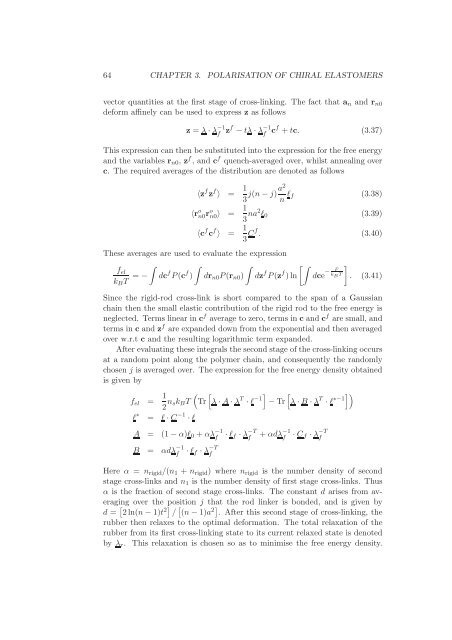Statistical models of elasticity in main chain and smectic liquid ...
Statistical models of elasticity in main chain and smectic liquid ...
Statistical models of elasticity in main chain and smectic liquid ...
You also want an ePaper? Increase the reach of your titles
YUMPU automatically turns print PDFs into web optimized ePapers that Google loves.
64 CHAPTER 3. POLARISATION OF CHIRAL ELASTOMERSvector quantities at the first stage <strong>of</strong> cross-l<strong>in</strong>k<strong>in</strong>g. The fact that a n <strong>and</strong> r n0deform aff<strong>in</strong>ely can be used to express z as followsz = λ·λ −1f zf −tλ·λ −1f cf +tc. (3.37)This expression can then be substituted <strong>in</strong>to the expression for the free energy<strong>and</strong> the variables r n0 , z f , <strong>and</strong> c f quench-averaged over, whilst anneal<strong>in</strong>g overc. The required averages <strong>of</strong> the distribution are denoted as follows〈z f z f 〉 = 1 3 j(n−j)a2 n l f (3.38)〈r o n0 ro n0 〉 = 1 3 na2 l 0 (3.39)〈c f c f 〉 = 1 3 Cf . (3.40)These averages are used to evaluate the expression∫ ∫ ∫ [∫f elk B T = − dc f P(c f ) dr n0 P(r n0 ) dz f P(z f )ln]dce − Fk B T. (3.41)S<strong>in</strong>ce the rigid-rod cross-l<strong>in</strong>k is short compared to the span <strong>of</strong> a Gaussiancha<strong>in</strong> then the small elastic contribution <strong>of</strong> the rigid rod to the free energy isneglected. Terms l<strong>in</strong>ear <strong>in</strong> c f average to zero, terms <strong>in</strong> c <strong>and</strong> c f are small, <strong>and</strong>terms <strong>in</strong> c <strong>and</strong> z f are exp<strong>and</strong>ed down from the exponential <strong>and</strong> then averagedover w.r.t c <strong>and</strong> the result<strong>in</strong>g logarithmic term exp<strong>and</strong>ed.After evaluat<strong>in</strong>g these <strong>in</strong>tegrals the second stage <strong>of</strong> the cross-l<strong>in</strong>k<strong>in</strong>g occursat a r<strong>and</strong>om po<strong>in</strong>t along the polymer cha<strong>in</strong>, <strong>and</strong> consequently the r<strong>and</strong>omlychosen j is averaged over. The expression for the free energy density obta<strong>in</strong>edis given byf el = 1 ( [2 n sk B T Tr λ·A·λ T ·l −1] −Tr[λ·B ·λ T ·l ∗−1])l ∗ = l·C −1 ·lA = (1−α)l 0 +αλ −1f·l f ·λ −Tf+αdλ −1f·C f ·λ −TfB = αdλ −1f·l f ·λ −TfHere α = n rigid /(n 1 + n rigid ) where n rigid is the number density <strong>of</strong> secondstage cross-l<strong>in</strong>ks <strong>and</strong> n 1 is the number density <strong>of</strong> first stage cross-l<strong>in</strong>ks. Thusα is the fraction <strong>of</strong> second stage cross-l<strong>in</strong>ks. The constant d arises from averag<strong>in</strong>gover the position j that the rod l<strong>in</strong>ker is bonded, <strong>and</strong> is given byd = [ 2ln(n−1)t 2] / [ (n−1)a 2] . After this second stage <strong>of</strong> cross-l<strong>in</strong>k<strong>in</strong>g, therubber then relaxes to the optimal deformation. The total relaxation <strong>of</strong> therubber from its first cross-l<strong>in</strong>k<strong>in</strong>g state to its current relaxed state is denotedby λ r . This relaxation is chosen so as to m<strong>in</strong>imise the free energy density.
















